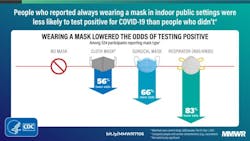CDC reports on the effectiveness of face mask use in indoor public settings for prevention of SARS-CoV-2 Infection
The Centers for Disease Control and Prevention (CDC) have released a new report reinforcing the importance of consistently wearing face masks or respirators to reduce the risk of acquisition of SARS-CoV-2 infection among the general public in indoor community settings.
The research was done during February–December 2021, and showed that using a face mask or respirator in indoor public settings was associated with lower odds of acquiring SARS-CoV-2 infection, with protection being highest among those who reported wearing a face mask or respirator all of the time. Although consistent use of any face mask or respirator indoors was protective, the adjusted odds of infection were lowest among persons who reported typically wearing an N95/KN95 respirator, followed by wearing a surgical mask.
These findings are consistent with existing research demonstrating that face masks or respirators effectively filter viruses in laboratory settings and with ecological studies showing reductions in SARS-CoV-2 incidence associated with community-level masking requirements.
While this study evaluated the protective effects of mask or respirator use in reducing the risk the wearer acquires SARS-CoV-2 infection, a previous evaluation estimated the additional benefits of masking for source control, and found that wearing face masks or respirators in the context of exposure to a person with confirmed SARS-CoV-2 infection was associated with similar reductions in risk for infection. Strengths of the current study include use of a clinical endpoint of SARS-CoV-2 test result, and applicability to a general population sample.
The findings of this report reinforce that in addition to being up to date with recommended COVID-19 vaccinations, consistently wearing face masks or respirators while in indoor public settings protects against the acquisition of SARS-CoV-2 infection. This highlights the importance of improving access to high-quality masks to ensure access is not a barrier to use. Using a respirator offers the highest level of protection from acquisition of SARS-CoV-2 infection, although it is most important to wear a well-fitting mask or respirator that is comfortable and can be used consistently.
The use of face masks or respirators (N95/KN95) is recommended to reduce transmission of SARS-CoV-2. Well-fitting face masks and respirators effectively filter virus-sized particles in laboratory conditions, though few studies have assessed their real-world effectiveness in preventing acquisition of SARS-CoV-2 infection. A test-negative design case-control study enrolled randomly selected California residents who had received a test result for SARS-CoV-2 during February 18–December 1, 2021. Face mask or respirator use was assessed among 652 case-participants (residents who had received positive test results for SARS-CoV-2) and 1,176 matched control-participants (residents who had received negative test results for SARS-CoV-2) who self-reported being in indoor public settings during the 2 weeks preceding testing and who reported no known contact with anyone with confirmed or suspected SARS-CoV-2 infection during this time.
Always using a face mask or respirator in indoor public settings was associated with lower adjusted odds of a positive test result compared with never wearing a face mask or respirator in these settings. These findings reinforce that in addition to being up to date with recommended COVID-19 vaccinations, consistently wearing a face mask or respirator in indoor public settings reduces the risk of acquiring SARS-CoV-2 infection. Using a respirator offers the highest level of personal protection against acquiring infection, although it is most important to wear a mask or respirator that is comfortable and can be used consistently.
